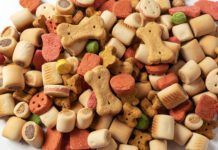What to Look for in Dry Dog Food:
1. Lots of animal protein at the top of the ingredients list
Ingredients are listed by weight, so you want to see a lot of top quality animal protein at the top of the list; the first ingredient should be a “named” animal protein source (see next bullet).
2. A named animal protein
Chicken, beef, lamb, and so on. “Meat” is an example of a low-quality protein source of dubious origin. Animal protein “meals” should also be from named species (look for “beef meal” but avoid “meat meal”).
3. An animal protein meal in a supporting role when a fresh meat is first on the ingredient list
This is to augment the total animal protein in the diet. Fresh (or frozen) meat contains a lot of water, and water is heavy, so if a fresh meat is first on the list, another source of animal protein should be listed in the top three or so ingredients. Fresh or frozen meats do not contain enough protein to be used as the sole animal protein source in a dry food; they contain as much as 65 to 75 percent water and only 15 to 25 percent protein. In contrast, animal protein “meals” – meat, bone, skin, and connective tissue that’s been rendered and dried – contain only about 10 percent moisture, and as much as 65 percent protein.
4. Whole vegetables, fruits, and grains
Fresh, unprocessed food ingredients contain nutrients in all their natural, complex glory, with their fragile vitamins, enzymes, and antioxidants intact. Don’t be alarmed by one or two food “fractions” (a by-product or part of an ingredient, like tomato pomace or rice bran), especially if they are low on the ingredients list. But it’s less than ideal if there are several fractions present in the food, and/or they appear high on the ingredients list.
5. A “best by” date that’s at least six months away
A best by date that’s 10 or 11 months away is ideal; it means the food was made very recently. Note: Foods made with synthetic preservatives (BHA, BHT, ethoxyquin) may have a “best by” date that is as much as two years past the date of manufacture.
What You Don’t Want to Buy:
– Meat by-products or poultry by-products
Higher-value ingredients are processed and stored more carefully (kept clean and cold) than lower-cost ingredients (such as by-products) by the processors.
– A “generic” fat source
Such as “animal fat.” This can literally be any fat of animal origin, including used restaurant grease and fats derived from roadkill. “Poultry” fat is not quite as suspect as “animal fat,” but “chicken fat” or “duck fat” is better (and traceable).
– Added sweeteners
Dogs, like humans, enjoy the taste of sweet foods. Sweeteners effectively persuade many dogs to eat foods comprised mainly of grain fragments (and containing little healthy animal protein).
– Artificial colors, flavors, or preservatives (i.e., BHA, BHT, ethoxyquin)
The color of the food doesn’t matter to your dog. And it should be flavored well enough to be enticing with healthy meats and fats. Natural preservatives, such as tocopherols (forms of vitamin E), vitamin C, and rosemary extract, can be used instead. Note that natural preservatives do not preserve foods as long as artificial preservatives, so owners should always check the “best by” date on the label and look for relatively fresh products.






#3 on the list above fails to mention that a lot of water must be added to recipes when meal powders are used as a protein source. Use of chicken meal, fish meal, etc. require approx. 4x their weight in added water to be used in the manufacturing process. Fresh meat, on the other hand, cooks in its own moisture and ZERO water is added in production. Such powders are also a cheap waste product with a denatured amino acid profile. There is no truth to a statement that says fresh meat cannot provide enough protein.